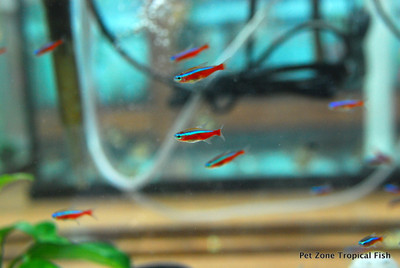Cardinal Tetra
Posted by Max Gandara on on 24th Aug 2025
The Cardinal Tetra (*Paracheirodon axelrodi*) is one of the most iconic and beautiful freshwater fish in the aquarium hobby. Closely related to the Neon Tetra, this species stands out with its more vibrant coloration and larger size, making it a favorite among aquarists worldwide.
Native to the blackwater rivers and streams of South America, particularly the Orinoco and Rio Negro basins, Cardinal Tetras thrive in soft, acidic waters shaded by dense jungle canopy. In these natural habitats, the dark tannin-stained water helps their bright colors stand out as a form of communication and schooling behavior.
Cardinal Tetras grow to about 2 inches long and are easily recognized by their striking appearance: a vivid, iridescent blue stripe running the length of their body, paired with a bold, bright red stripe that extends from the middle of the body all the way through the tail. This distinguishes them from the Neon Tetra, whose red stripe only covers half the body.
They are peaceful schooling fish and should be kept in groups of at least 6–10 or more. Larger schools make them feel more secure and create a dazzling visual display in the aquarium. Their gentle temperament makes them excellent companions for other small, peaceful species such as rasboras, dwarf gouramis, corydoras, and shrimp.
Cardinal Tetras prefer aquariums with plenty of plants, subdued lighting, and open swimming areas. A soft substrate, driftwood, and leaf litter help replicate their natural blackwater environment. They do best in stable water conditions, with temperatures of 75–82°F, a pH of 5.0–7.0, and soft water.
These tetras are omnivorous and thrive on a diet of high-quality flakes or micro pellets, along with live or frozen foods such as daphnia, brine shrimp, and bloodworms. A varied diet enhances their coloration and overall health.
Cardinal Tetras can live 4–5 years with good care, though in well-maintained aquariums, they may live even longer. Their vibrant colors, peaceful schooling behavior, and elegance make them a classic choice for planted and community tanks, offering both beauty and harmony to any setup.

